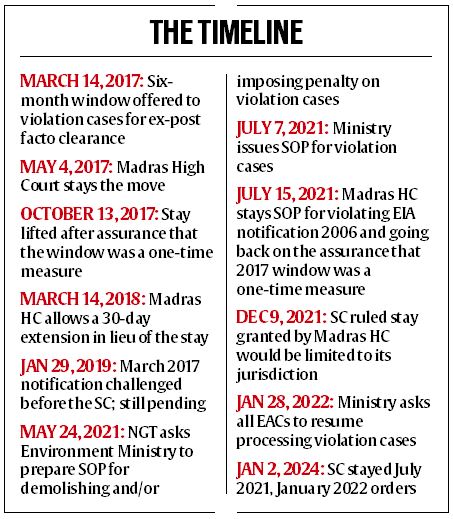AN AMNESTY window opened for just six months in March 2017 to clear projects in a novel “violation category” became routine through a Union Environment Ministry notification in July 2021, and provided ex-post facto approval to over 100 projects till the Supreme Court stayed the notification in January this year.
Projects that started work without obtaining a mandatory prior environmental clearance or exceeded the limits set as clearance conditions fall under the “violation category”.

Besides clearing over 100 projects, the ministry also issued terms of reference (ToR) for impact assessment to at least another 150 (see chart) under the violation category. Once a project is considered fit for appraisal, ToR is issued for assessing its environmental impact and a final decision on the clearance depends on that assessment.
 Projects cleared under violation category
Projects cleared under violation category
Coal, iron and bauxite mines, a greenfield airport, multiple distilleries, steel and iron factories, industrial estates, cement plants and limestone quarries, chemical units and building construction sites — these are the projects cleared by the Union Environment Ministry under the “violation category” since March 2017.
Conceived as a one-time opportunity, it became a routine process when the Union Environment Ministry notified a “Standard Operating Procedure (SOP) for identification and handling of violation cases” in July 2021.
Project developers who benefitted over the last six years include Singareni Collieries Company Limited, Mahanadi Coalfields Limited, Jaypee Cement, UltraTech Cement, Ramco Cements, Bhushan Steel Limited (Tata Steel), Steel Authority of India, Godrej Agrovet Limited, Hindustan Copper, Lloyds Metals & Energy Limited, Hindustan Marble, Artemis Hospital, Pushpawati Singhania Hospital, Spaze Towers, Hotel Leela Venture Ltd, Special Protection Group etc.
PV Jayakrishnan, former Environment secretary and former Chairman of the Supreme Court’s Central Empowered Committee (CEC) until it was reconstituted last year, said such policies did not help the regulatory process. “In principle, ex-post facto clearance should be avoided as it only complicates matters,” he told The Indian Express.
Story continues below this ad
ExplainedWaiting for SC
By turning a six-month window for clearing projects which violated clearance conditions into a routine process, the Environment Ministry allowed for at least 100 projects to sail through. These include power projects, an airport. Now the Supreme Court will take a call.
Prodipto Ghosh, former Environment Secretary and one of India’s climate change negotiators at the UNFCC during 2001-2012, pointed out that the EIA Notification 2006 was aligned with the international practice of prior clearance. “It is one thing to remedy technical violations if a project deviates from certain clearance conditions, quite another to condone projects that started work without obtaining the necessary clearances,” he said.
 Timeline
Timeline
Judgements by the Supreme Court in Common Cause versus Union of India (2017) and Alembic Pharmaceuticals versus Rohit Prajapati (2020) have held that the concept of ex-post facto clearance is against the fundamental principle of environmental jurisprudence and the EIA Notification 2006 which requires a prior environment clearance.
Records reviewed by The Indian Express show that an Expert Appraisal Committee (EAC) set up to deal with violation cases met 46 times between June 2017 and June 2021 and recommended at least 112 projects. Of this, at least 55 were granted environmental clearances. The rest have been issued terms of reference (ToR) for environmental impact assessment and remediation plans.
Since July 2021 when “handling of violation cases” became a routine procedure, the ministry’s ten EACs – industry 1-3, infrastructure 1-2, thermal, hydro, coal mining, non-coal mining and CRZ — that deal with projects in different sectors have met over 400 times and recommended at least 144 projects under “violation category”. Of this, at least 46 have been issued final environmental clearances.
Story continues below this ad
The maximum number of violation cases were cleared by the EAC dealing with projects in the chemical industries sector, followed by those handling the mining (coal and non-coal) sectors and the mineral-based industries.



 Projects cleared under violation category
Projects cleared under violation category Timeline
Timeline





